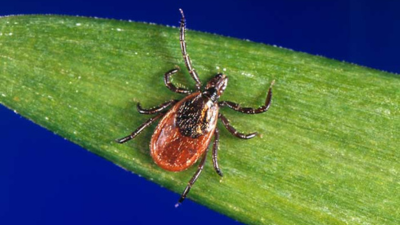Daily News
Prevention and Early Detection Are Effective Tools Against Tickborne Disease
– Residents urged to prevent tick bites as weather warms up and area physicians reminded to consider tickborne disease when evaluating patients. –

CINCINNATI – May 6, 2024 – The Cincinnati Health Department (CHD) is advising residents to take measures now to prevent tickborne disease as the weather warms up, and reminding physicians to be on the lookout for patients presenting with symptoms who have recent tick exposure.
In 2023, Ohio reported 1,297 cases of Lyme Disease 2.18 times more cases than in 2022, when 593 cases were reported. State data show more tickborne disease illnesses begin between the months of May and November in Ohio than December through April, with the highest months being June and July (see chart on right).
Tick bite prevention can include avoiding tick habitats when possible, using U.S. Environmental Protection Agency-approved insect repellants, like DEET, when outdoors, showering immediately after returning indoors, performing tick checks, and removing ticks promptly.
When performing tick checks, people should pay special attention to under the arms, in and around the ears, inside belly button, backs of knees, in and around hair, between the legs, and around the waist. People with pets should do the same for their indoor/outdoor pets, so they are also less susceptible to tickborne disease and less likely to carry ticks into their family’s yard and home.
“Recognition of tickborne illness as soon as symptoms begin and the proper treatment received from a health care provider can significantly reduce the severity and duration of the patient’s symptoms,” said Grant Mussman, M.D, MHSA, Cincinnati Health Department Commissioner.
According to the Ohio Department of Health (ODH), many tickborne diseases can have similar signs and symptoms. The most common symptoms of tick-related illnesses are:
- Fever/chills: With all tickborne diseases, patients can experience fever at varying degrees and time of onset.
- Aches and pains: Tickborne disease symptoms include headache, fatigue, and muscle aches. With Lyme disease, patients may also experience joint pain. The severity and time of onset of these symptoms can depend on the disease and the patient's personal tolerance level.
- Rash: Lyme disease, southern tick-associated rash illness (STARI), Rocky Mountain spotted fever (RMSF), ehrlichiosis, and tularemia can result in distinctive rashes.
Physicians are also encouraged to help their patients by increasing their awareness of Lyme disease and other tickborne diseases and educating them on preventive actions to avoid the disease before they experience symptoms.
For more information about ticks and preventing the diseases ticks may transmit, visit https://odh.ohio.gov/know-our-programs/zoonotic-disease-program/diseases/tickborne-diseases. CHD has educational brochures and tick identification kits available to residents and physicians. Call 513-357-7391 for more information.
For more information about ticks and preventing the diseases ticks may transmit, visit https://odh.ohio.gov/know-our-programs/zoonotic-disease-program/diseases/tickborne-diseases.
CHD Communicable Disease Dashboard:
(See page 4 for Lyme disease data.)
